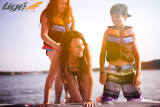
National Safe Boating Week: Little Boaters
May 24, 2013
Getting a good fit is important. Unlike shoes, a child’s life jacket should fit snugly from day one. Don’t make the mistake of buying a life jacket that a child will “grow into.”
The Coast Guard recommends that boaters wear a life jacket at all times on the water, regardless of age. Children, especially very young children, often don’t understand danger. Know that a life jacket can help protect your child on the water, as well as in hazardous areas around piers.
Children’s life jackets now have lots of eye appeal too. Marine manufacturers have incorporated new designs and technologies into children’s safety equipment, coming up with life jackets and life jacket-type swimwear in bright colors and cartoon prints. Children’s jackets are also constructed to provide extra protection. Many models for infants and toddlers have built-in head support that will the turn the wearer face-up in the water, and most are built with extra buoyancy or other safety features just for children.
Height and weight can vary widely within age groups, so taking your child along for a life jacket fitting is very important. Remember that swim aids and water wings are toys and do not meet safety requirements.
Look for the U.S. Coast Guard approval label on the inside of the life jacket. This tells you the jacket has passed stringent tests for safety and durability. Check the label and match your child’s weight to the range listed. Note that although some children in the 30-50 pound weight range who can swim may like the extra freedom of movement that a Type III life vest or belt pack provides, most children in this weight range, especially those who can’t swim, should wear a Type II life jacket. The label will tell you which type it is.